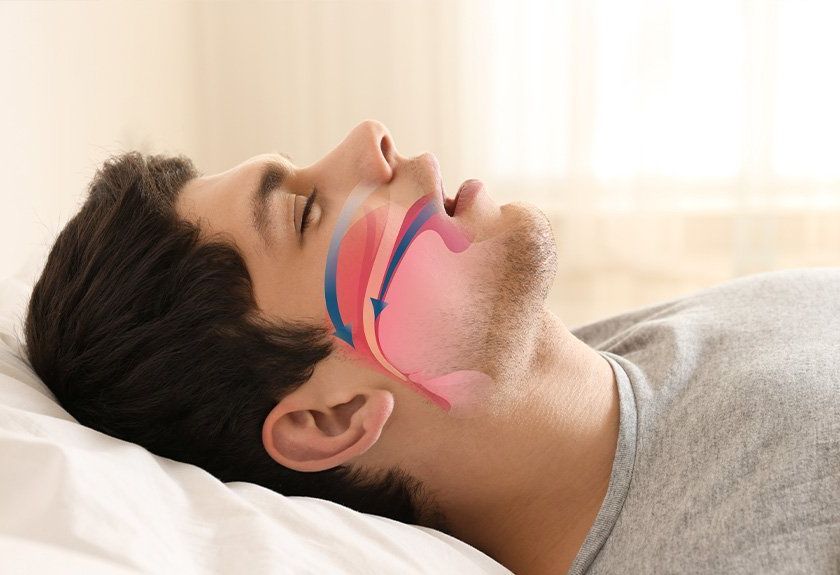Cancer, Obstructive Sleep Apnea and Sleep-Disordered Breathing
It’s well known that obstructive sleep apnea (OSA) and other forms of sleep-disordered breathing (SDB) are associated with high blood pressure and cardiovascular disease. Now, recent evidence suggests that the presence of these breathing issues results in higher rates of mortality from cancer.
A
2012 study from the University of Wisconsin found that mortality increases as the severity of sleep-disordered breathing increases. In fact, this long-term study of more than 1,500 individuals in Wisconsin found that those with sleep apnea died from cancer at a rate about 4.8 times higher than those with no sleep breathing problems. A
similar study in 2019 found that people with severe obstructive sleep apnea were about 1.35 times more likely to be diagnosed with prostate cancer (for men) or breast cancer (for women). This study found the risk is higher for women with obstructive sleep apnea than for men.
If you are concerned about your sleep apnea and cancer risk, reach out to Breath of Life Dental to schedule an evaluation with Dr. Maryam Seifi. She will help ensure your sleep-disordered breathing is fully handled to reduce your cancer risk and help you get the rest you deserve at night. Call us at
(301) 818-2653 to schedule your appointment today.
How Can We Help You?
What Exactly Is Cancer?
In simple terms,
cancer
is a type of disease where cells in the body begin to grow and divide uncontrollably. When this happens, the extra cells can form a
tumor, which is a collection of excess cells in the body. These tumors can be
malignant, meaning they spread to nearby tissues and cause harm, or they can be
benign, meaning that there are still excess cells in the body but they aren’t causing any harm.
What Causes Cancer?
Cancer is caused by cell mutation, which is when the genetic structure of cells in the body is changed. Cell mutation can happen when cells divide, when cells are damaged, or when the mutation is inherited from one’s parents.
Most of the time, the human body can detect and handle these mutated cells before they can cause any harm. But in some cases, the mutated cells are not caught in time and can reproduce, creating more and more cells with the wrong set of instructions. If the mutated cells start moving into other parts of the body and causing damage, it’s called
cancer.
Mutation During Cell Division
Each cell has a set of instructions (DNA) that tells it what to do in the body. When cells reproduce, they copy these instructions so that the new cells also know what to do in the body. Sometimes, there is an error in the copy, and the new cells don’t have the right instructions for their purpose in the body. This can cause the new cells to do things they shouldn’t do. Every cell in the body serves a specific purpose, so having cells that are not taking care of that purpose or doing something else entirely can lead to unwanted medical conditions like cancer.
Mutation Due to Damage
Even though the body’s cells are very small, they can still get damaged. Sometimes, the type of damage a cell experiences causes it to mutate. While there is no single cause for cancer, scientists agree that the following types of damage to cells can increase one’s risk of developing this disease:
- Radiation exposure, such as from the sun or x-rays
- Smoke inhalation from cigarettes, pollution, exhaust, etc.
- Chemical exposure, such as pesticides, dyes, or certain acids
- Hormone use, such as in hormonal birth control
- Obesity, which increases hormone production and inflammation
Mutation Due to Family Genetics
Cancer itself is not a type of gene that can be passed down from parents to children like eye color or dimples. However, if one or both parents has a specific type of mutated gene, it is possible to pass that mutation down to their child. Then, when those mutated cells reproduce, it can cause cancer. This doesn’t mean that a child who inherits a mutated gene from their parent(s) will absolutely develop cancer. It does mean that they will have
an increased risk of developing cancer.
Types of Cancer
So far, scientists have found over 150 different types of cancer. But there are about 200 different types of cells in the human body, and any one of them can experience a mutation. Essentially, cancer can develop in any part of the body, but the most commonly diagnosed types of cancer incidence in the United States occur in the:
Types of Cancer
- Breast
- Prostate
- Lung
- Colon
- Skin
- Bladder
- Lymphatic system
- Kidney
- Uterus
- Blood
- Pancreas
- Thyroid system
Symptoms of Cancer
Because there are so many different types of cancer, there are also a wide variety of symptoms, and these symptoms can vary between men and women. Additionally, many of the symptoms of cancer are also symptoms of other diseases, vitamin and mineral deficiencies, or health problems unrelated to cancer. In general, the following symptoms could be indicative of cancer if they become chronic or get progressively worse over time:
- Fatigue
- Headaches
- Body aches and pains
- Lumps
- Persistent cough
- Unusual bruising
- Vision problems
- Hearing problems
- Sudden weight loss
- Lack of appetite
- Difficulty breathing
- Painful urination
Treatment for
Cancer
There are many different treatments for cancer depending on the type of cancer one has and at what stage it is diagnosed. In general, the earlier cancer is detected, the easier it is to treat, which is why routine checkups from a physician are an important step in maintaining good health. Some common cancer treatments include:
- Chemotherapy, which uses specific drugs to kill cancerous cells.
- Hormone therapy, which can slow down or stop the growth of cancerous cells.
- Immunotherapy, which helps give the immune system the strength to fight cancer
- Radiation therapy, which can kill cancerous cells or shrink tumors
- Surgery, where a surgeon physically removes cancerous cells from the body
It is also important to keep in mind that scientists are continually making new discoveries about cancer and developing effective treatments for this disease. While more research is needed to fully understand and eradicate cancer, there are many treatment options that can send cancer into remission (meaning the symptoms are gone and the cancer, while still present, is no longer harming the body) or remove it from the body entirely. By getting routine physical examinations and checkups as recommended by your physician, you will increase your chances of catching cancer in its earliest stages when it is easier to treat.
What Is Sleep-Disordered Breathing?
Sleep-disordered breathing (SDB) is a term used to describe any condition that causes the body to breathe abnormally or stop breathing during sleep. The body’s autonomic nervous system, which is made up of nerves spread throughout the body that carry information between the body and the brain, is what regulates breathing. The reason we don’t have to consciously remind ourselves to breathe is because the autonomic nervous system is taking care of it for us. But when there is a problem with this system, or when something physically blocks a person’s airway, it can lead to sleep-disordered breathing.
Types of Sleep-Disordered Breathing
There are several different types of sleep disorders that can affect the breathing patterns of adults or children, including:
- Obstructive sleep apnea (OSA) – when the airway gets blocked during sleep and causes one to suffocate.
- Central sleep apnea (CSA) – when issues in communication between the brain and the respiratory system cause breathing to stop.
- Complex sleep apnea – when, upon receiving treatment for obstructive sleep apnea, one begins to experience central sleep apnea.
- Sleep-related hypoventilation – when carbon dioxide levels in the blood are elevated during sleep due to insufficient breathing.
- Sleep-related hypoxemia – when oxygen levels in the blood are too low during sleep.
- Catathrenia – when a monotonous groaning sound comes out of a person’s throat when they exhale during sleep, which can last as briefly as 1 second or as long as over 30 seconds.
Symptoms of Sleep-Disordered Breathing
The specific symptoms of sleep-disordered breathing (SDB) can vary depending on the type of SDB one is experiencing. However, as SDB affects a person’s ability to achieve a full night’s rest, there are
common symptoms among these conditions, including:
- Fatigue
- Memory problems
- Loud snoring
- Morning dry mouth
- Morning headaches
- Inability to focus
- Low sex drive
- Unexplained mood changes
- High blood pressure
- Depression
- Anxiety
- Sudden short temper
- Insomnia
- Choking or gasping during sleep
Treatments for Sleep-Disordered Breathing
There are several different types of treatment available for sleep-disordered breathing depending on the cause of the disorder.
- Continuous positive airway pressure (CPAP) – a machine that handles the symptoms of obstructive sleep apnea by applying continuous airflow through a face mask while a person sleeps.
- Bilevel positive airway pressure (BiPAP) – a machine with the same purpose as a CPAP machine, however it changes the air pressure depending on whether the wearer is breathing in or breathing out.
- Oral appliance therapy – the use of specialized oral appliances to correct the causes of sleep apnea and enable a person to get a full night’s rest.
- Surgery – for patients with OSA, there are different surgical procedures that can widen the airway to correct the issue.
- Lifestyle changes – often, making healthier lifestyle choices such as losing weight or abstaining from smoking and drinking alcohol can reduce symptoms of sleep-disordered breathing and provide relief.

What Is the Relationship Between Obstructive Sleep Apnea and Cancer?
There have been
a number of studies done examining the link between cancer and sleep apnea. While scientists cannot definitively state that sleep apnea causes cancer, there is reasonable evidence to believe that untreated severe sleep-disordered breathing such as apnea can increase the risk of developing cancer and cancer mortality.
There are two common factors among all types of sleep-disordered breathing: intermittent
hypoxia and sleep fragmentation. While scientists cannot definitively state that these two factors
cause
cancer, the results of
scientific research do show that both intermittent hypoxia and sleep fragmentation cause significant side effects that can decrease the strength of the body’s immune system and increase the aggressiveness of cancerous cells.
Intermittent Hypoxia
Hypoxia
is when there are low levels of oxygen in the blood or body tissues.
Intermittent hypoxia is when those oxygen levels go down and up throughout the night due to sleep-disordered breathing. This is because conditions like sleep apnea cause a person to stop breathing, which leads to low blood oxygen (hypoxia). Then, when they wake up gasping for air, their blood oxygen levels go back up.
This condition is not good for the health of the body. Not only does the body need oxygen to survive, but these bouts of suffocation increase the production of stress hormones in the body to help prepare to take action—in other words, these situations cause a
fight-or-flight response. While these physical reactions can help in an emergency, experiencing the effects of stress hormones nightly can negatively impact a person’s immune system, sleep quality, and heart health.
Sleep Fragmentation
Sleep fragmentation is when a person’s sleep is repeatedly interrupted or broken into pieces. In people with sleep-disordered breathing, this happens because the body wakes up suffocating multiple times per night in order to get oxygen. But the body in these cases is not staying asleep long enough to get into the
restorative deep sleep stage where cell repair happens.
When the body cannot get deep sleep, the immune system gets weakened. In one study, it was found that fragmented sleep
negatively impacts the immune system to such a degree that cancerous cells can more aggressively attack the body. While the fragmented sleep itself does not cause cancer, it makes it much more difficult for the body to fight back against cancer and can increase cancer mortality.
Can Sleep Apnea Treatment Reduce Cancer Risk?
No one can say with 100% confidence that sleep apnea treatment will reduce a person’s risk of developing or dying from cancer. What we can say is this: we do know what the negative effects of untreated, severe sleep-disordered breathing are on the body. We also know how those same effects can lead to cancer becoming more aggressive and harder to treat. And from the scientific studies mentioned earlier, we know that people with severe sleep-disordered breathing conditions (like obstructive sleep apnea) are about
4.8-times more likely to die from cancer if those conditions are left untreated.
It stands to reason that sleep apnea treatment can not cure cancer, but it can cure sleep apnea and thereby lower a person’s risk of developing or dying from cancer. Considering the many benefits of sleep apnea treatment, it should be an easy choice to make to seek out treatment for obstructive sleep apnea or any other type of sleep-disordered breathing.

Benefits of Sleep Apnea Treatment
The quality of your sleep affects nearly every aspect of your physical, mental, and emotional health and wellbeing. If your sleep is being constantly interrupted by episodes of apnea, receiving treatment can change your life. Some of the most common benefits of sleep apnea treatment include:
- Improved sleep quality with deeper, more restorative sleep.
- Improved concentration, focus, and productivity during the day.
- Decreased strain on the heart, which reduces the risk of cardiovascular problems such as high blood pressure, atrial fibrillation, heart attacks, and strokes.
- Decreased risk of developing insulin resistance and type 2 diabetes.
- Improved mood with less incidents of depression, anxiety, or anger
- Reduced risk of accidents caused by daytime drowsiness or lack of focus
- Improved cognitive function such as memory, attention, and cognitive processing.
- Reduced morning headaches due to low oxygen or high carbon dioxide levels during sleep.
- Improved sexual health and desire
- Better quality of life thanks to improved sleep quality, energy levels, mood, and overall health.
Tips to Prevent Sleep Apnea
There are several different actions you can take to reduce your risk of developing sleep apnea or handle your symptoms if you’ve already been diagnosed with this condition:
1. Maintain a healthy weight
Obstructive sleep apnea (OSA) can be caused by excess body fat around the neck. This can constrict your airway when you sleep and lead to OSA. If you are overweight or obese, improving your diet with nutritious foods and starting a simple daily exercise routine can help you lose weight, which in turn can reduce the pressure on your airway at night and prevent OSA.
2. Quit smoking
Smoking can lead to sleep apnea because it irritates and inflames the throat and sinuses. Quitting smoking can reduce this inflammation and lower your chances of developing sleep apnea.
3. Don’t use sedatives
Sedatives are drugs that relax your muscles, and this includes the muscles in your throat. Taking this type of medication can lead to or exacerbate obstructive sleep apnea symptoms. It’s best to limit the use of these drugs to reduce your chances of developing sleep apnea. Talk to your doctor about lowering your dosage or quitting sedative medications entirely.
4. Reduce alcohol consumption
Alcohol is also a sedative that relaxes your muscles. It can also make it more difficult for your body to wake up if you experience an episode of apnea while asleep. Limiting alcohol consumption or abstaining entirely can reduce your risk of obstructive sleep apnea and improve your overall health.
5. Don’t sleep on your back
Sleeping on your back can lead to obstructive sleep apnea from your tongue if gravity pulls your tongue back against your airway. Sleeping on your side or stomach lowers this risk and can lower your chances of developing obstructive sleep apnea. This can also help you manage your symptoms if you already have OSA.
Disclaimer
This article provides information about cancer and obstructive sleep apnea based on current research and understanding. While every effort has been made to ensure accuracy, this content is for informational purposes only and should not be taken as medical advice. This article is not intended to replace professional medical diagnosis or treatment; do not use this information to diagnose or treat any health issues or diseases. Always seek the guidance of a qualified health professional for any questions you may have about your medical conditions or if you are experiencing any concerning symptoms.
Find
Out More
Dr. Maryam Seifi of Breath of Life Dental believes the increased oxygenation of the body which occurs when OSA if resolved could aid the survival of cancer patients. She is educating the public on a new FDA-approved device that provides a permanent solution to these breathing difficulties. No surgery or CPAP devices are required.
Contact Breath of Life Dental at
(301) 281-4295 or via this website to schedule attendance at an educational seminar or to consult personally with
Dr. Seifi.
Disclaimer
This article provides information about cancer and obstructive sleep apnea based on current research and understanding. While every effort has been made to ensure accuracy, this content is for informational purposes only and should not be taken as medical advice. This article is not intended to replace professional medical diagnosis or treatment; do not use this information to diagnose or treat any health issues or diseases. Always seek the guidance of a qualified health professional for any questions you may have about your medical conditions or if you are experiencing any concerning symptoms.
Disclaimer: The information contained on this website is not intended to be a substitute for professional medical advice, diagnosis, or treatment of a medical issue. Breath of Life Dental encourages you to seek the advice of your physician or you may call our office with any questions you may have regarding TMD or sleep apnea. Everything contained on this website is presented for informational purposes only. While there are many commonalities among multiple TMD and sleep apnea cases, each patient is unique. Information on this website is strictly for educating the reader about what they should discuss with their doctor if they are suffering from the listed symptoms. If you think you may have a medical emergency, call your doctor or 911 immediately.
301-719-3123
Breath Of Life Dental is registered as a Trade Mark Privacy Policy | Cookie Policy | Accessibility Statement | Notice of Privacy Practices | Terms and Conditions
All Rights Reserved | Breath of Life Dental, an office of Dr. Maryam Seifi
Website designed and maintained by Xpress, INC












